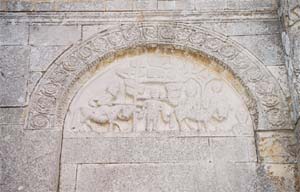![]() Sacred
architecture
Sacred
architecture
![]() Termoli
Cathedral
Termoli
Cathedral
![]() Saint
Mary della Strada in Matrice
Saint
Mary della Strada in Matrice
The
church of St Mary della Strada in Matrice is located on a side track of the
Pescasseroli-Candela sheep-track. Because of its position the building,
consecrated in 1148, became an important stopover for pilgrims that from the
hinterland of present-day Molise travelled to the Apulian sanctuaries. The
building has a rectangular triapsidal floor plan. The interior is divided into
three naves by columns with squat capitals ornamented with highly stylised
vegetal patterns. The presbytery is raised three steps above the level of the
naves. The exterior, which is characterised by an elegant stone face made of
large well-squared ashlars, has a richly decorated fašade and right-hand side
portal, which was probably the work of artists. The decoration of the main fašade
is very complex and not yet completely clear from an iconographic viewpoint:
at the top, on the sides of a rose-window, three animal figures appear in high
relief, while animal scenes, some of which fantastical, and human figures
accompanied by floral, vegetal and geometrical patterns, appear in a less
accentuated relief in the tympanum and lunette on the central portal. Other
figured scenes appear in the two lunettes on the sides of the portal:
according to some interpretations they represent episodes from two different Chansons
de gestes, the Libro di Fioravante
and the Historia Karoli Magni et
Rotholandhi. The scene in the lunette on the side portal is clearer: it
depicts the myth of Alexander the Great, whose carriage is drawn skyward by
two griffins.
Other works of medieval sculpture are preserved in the church, including the
fourteenth-century tombstone of Bernardo di Aquino.
 |
The
left-hand lunette
The
scene depicted in the lunette is probably a representation of Fioravante
freeing a maid abducted by three Saracens. Of special interest is the figure
of the hero on the right, represented astride his horse in the act of
attacking the Saracens. He wears the typical garb of a Norman warrior of the
time of Roger II de Hauteville, an iron mesh armour without hood, a
vertical-ribbed helmet without nosepiece and an almond-shaped shield.
 |
 |
Two
bronze door-knockers
Two bronze door-knockers with leonine protomes, dating back to the first
half of the 12th century and probably designed for a door of the church, are
preserved in the church of St. Cristina at Sepino. The protomes, which are
attached to a disk decorated with geometrical patterns, have stylistic
affinities with similar pieces found on the door of the cathedral of Troia,
built by Oderisio da Benevento and dating back to 1127. These analogies lead
us to hypothesise that the artefacts originate from the same workshop and are
therefore to be considered important figurative evidence of the connections
between Benevento and the Molisian town, which at the time was part of the
territory of the Norman Duchy of Bojano.
 |
![]() Saint
George in Petrella Tifernina
Saint
George in Petrella Tifernina
![]() Saint
Angelo in Grotte
Saint
Angelo in Grotte